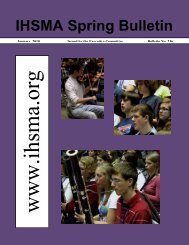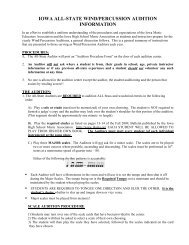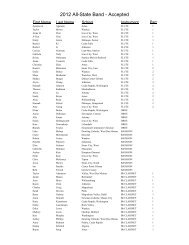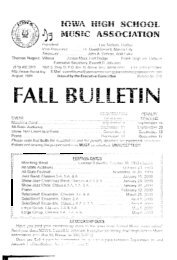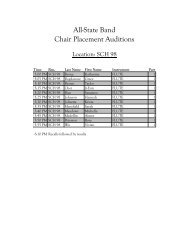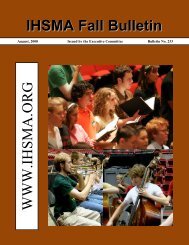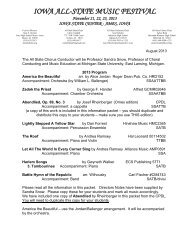Fall Bulletin No. 235 - August 2009 - The Iowa High School Music ...
Fall Bulletin No. 235 - August 2009 - The Iowa High School Music ...
Fall Bulletin No. 235 - August 2009 - The Iowa High School Music ...
Create successful ePaper yourself
Turn your PDF publications into a flip-book with our unique Google optimized e-Paper software.
Community Technology Foundation of CA7 PolicyLink |Redefining the Digital Divide:Implications for E-AdvocacyAfter more than a decade of progress, adigital divide persists along racial lines,between higher-educated and less-educatedindividuals, and between higher-income andlower-income households. In 2006, white non-Hispanic adults are 20 percent more likely thanAfrican-Americans to use the Internet. Thosewith a college degree are 42 percent morelikely to use the Internet than those with onlya high school diploma, and households whoearn more than $50,000 a year are 63 percentmore likely to be Internet users thanhouseholds earning less than $30,000 a year. 14Despite the persistent gap in Internet accessbetween underrepresented groups and others,it is important to emphasize that racialminorities, the poor, and the less-educated areindeed online. In fact, they are online in largenumbers. In early 2006, 61 percent of African-Americans and 76 percent of English-speakingHispanics were online. In addition, more thanhalf of the households with annual incomes ofless than $30,000 a year used the Internet aswell as 64 percent of those with only a highschool diploma. 15Importantly, however, being online or offlineare no longer the definitive aspects of the“digital divide.” <strong>The</strong> contemporary divide iscentered on issues of bandwidth, usage, andcontent. One sign with promising implicationsfor the future of e-advocacy and underservedcommunities is the increasing access to and useof high-speed Internet connections by peopleof color. As of March 2006, 42 percent of allAmerican adults had broadband Internetconnections at home. This is an increase of 40percent compared to March 2005. Forcommunities of color, the rate of broadbandadoption is actually much faster than for thepopulation as a whole. From March 2005 toMarch 2006, the rates of growth in homebroadband Internet connections for African-Americans and English-speaking Hispanicsgrew faster than the rate for whites. <strong>The</strong>percentage of African-American adults withbroadband Internet access at home grew by anastounding 121 percent in just one year,increasing from 14 to 31 percent. For Hispanicswho speak English, those with broadbandInternet connections at home rose from 28 to41 percent, reaching near parity with whites at42 percent. 16Broadband access at home is notable amongtraditionally underserved communities becausehigher Internet access speeds tend to changethe behavior of online users. In particular, onany given day a broadband user takes part inseven different online activities compared tojust three for dial-up users. 17 And, contrary topast trends, broadband access is now astronger predictor of intensity of Internet usethan the number of years an Internet user hasbeen online. 18 Important from an advocacystandpoint, broadband Internet users are morelikely to engage in activities such as searchingfor political information or producing andsharing content online. Internet users withbroadband at home are more than two-and-ahalftimes more likely to look for politicalinformation on the web than dial-up users.Moreover, broadband users are more thanthree-and-a-half times more likely to createcontent and share it online compared to dialupusers. 19Integrated Advocacy Strategies:An Optimal Approach for MakingChange<strong>The</strong> significant presence of underservedcommunities on the Internet, including thosethat have broadband Internet connections athome and those using dial-up, as well otherswho are not yet online, suggests that advocacyorganizations must adopt integratedapproaches that exploit the power of theonline world along with the enduringstrengths of traditional offline strategies.Your Guide to the E-Advocacy Revolution √



